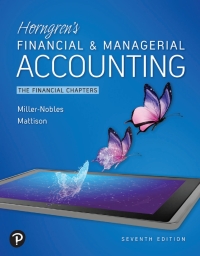Question
Cost of 90% (900 1,000) of SET 63,000 Implied value of 100% of SET 70,000 Shareholders' equity Total Preferred Ordinary Preferred stock 40,000 42,000 1

Cost of 90% (900 1,000) of SET 63,000
Implied value of 100% of SET 70,000
Shareholders' equity Total Preferred Ordinary
Preferred stock 40,000 42,0001 (2,000)
Ordinary shares 20,000 20,000
Retained earnings 30,000 8,0002 22,000
90,000 50,000) 40,000
Acquisition differential (all allocated to patents) 30,000
Patent amortization Year 5 (six-year life) (5,000)
Unamortized patent, December 31, Year 5 25,000
NCI, date of acquisition
- interest in common shares (10% x 70,000) 7,000
- interest in preferred stock (100% x 50,000) 50,000
Total 57,000 (a)
Calculation of consolidated profit
PET profit 30,000
Less: Dividends from SET3 (2,700)
27,300
SET profit 22,000
Less: Patent amortization (5,000) 17,000
Consolidated profit 44,300
Attributable to:
PETs shareholders 39,000
NCI (4,0004 + 10% x [17,000 4,0004]) 5,300
44,300
Notes:
- Liquidation value of 40,000 x 1.05 = 42,000
- Dividends in arrears: 4,000 shares x $1/year x 2 years = 8,000
- Dividends on ordinary shares: (15,000 4,000 x $1/year x 3 years) x 90% = 2,700
- Income for preferred: 4,000 x $1/year x 1 year = 4,000
How do I find the values in notes 3 and 4?
On January 1, Year 5, PET Company acquired 900 ordinary shares of SET Company for $63,000. On this date, the shareholders' equity accounts of SET Company were as follows: Ordinary shares (1,000 no par value shares issued) $20,000 Preferred shares (4.000 no par value shares issued) (Note 1) 40,000 Retained earnings 30,000 $90,000 Note 1: The preferred shares are $1, cumulative, non-participating with a liquidation value of 1.05. They were two years in arrears on January 1, Year 5. The following are the statements of retained earnings for the two companies for Year 5: PET SET $50,000 $30,000 Retained earnings, beginning of year Profit 30,000 22,000 Dividends (25.000) (15,000) Retained earnings, end of year $55,000 $37,000 . Additional Information PET uses the cost method to account for its investment in SET. Any acquisition differential is allocated to patents with an estimated useful life of six years as at January 1, Year 5. Neither company has any patents recorded on their separate-entity recordsStep by Step Solution
There are 3 Steps involved in it
Step: 1

Get Instant Access to Expert-Tailored Solutions
See step-by-step solutions with expert insights and AI powered tools for academic success
Step: 2

Step: 3

Ace Your Homework with AI
Get the answers you need in no time with our AI-driven, step-by-step assistance
Get Started


